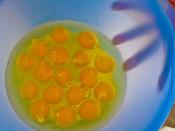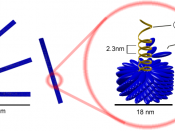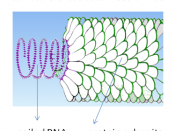Notes
pg. 455-461
Biologists first suspected the existence of viruses near the end of the nineteenth century. At that time, European scientists were seeking to identify the infectious agent responsible for tobacco mosaic disease, a disease that stunts the growth of tobacco plants and makes their leaves blotchy. One experiment used fine-pored porcelain filters to strain bacteria from sap extracted from infected tobacco plants. The pores in these filters were so small that bacteria could not pass through them. However, the infectious agent passed through the filters without difficulty. Scientists concluded that the infectious agent must be smaller than a typical bacterial cell. After further investigation, the scientists found that the agent could reproduce only inside the living cells it infected. They called the agent a virus, a Latin word meaning "poison."
The true nature of viruses was discovered in 1933 when the biologist Wendell Stanley of the Rockefeller Institute tried to purify an extract of the tobacco mosaic virus (TMV). To his great surprise, the purified TMV extract formed crystals, a property of chemicals. Stanley concluded that TMV is chemical matter rather than a living organism.
Within a few years of Stanley's findings, scientists were able to disassemble TMV and confirm his conclusion. TMV is a chemical, not a cell. Each particle of TMV is made of only two kinds of molecules: the nucleic acid RNA and protein.
TMV consists of a core of RNA surrounded by a coat of protein. Later scientists were able to separate the RNA from the protein. When they reassembled the two components, the reconstructed TMV particles were fully able to infect healthy tobacco plants. The chemicals were the virus itself, not merely derivatives of it. Through this experiment and others, a general picture of virus structure and function has emerged. A...



Biology notes on viruses
Anybody who rates these notes negatively is off their rocker.
This isn't supposed to be an essay people, this is a set of notes, and they are quite thorough and informative which means that they are valuable research and study tools. I do believe that is what cheathouse was created for. To assist students with research and studying and these notes are quite beneficial.
Don't be disheartened ccmustangs2001, good job.
0 out of 0 people found this comment useful.